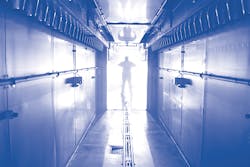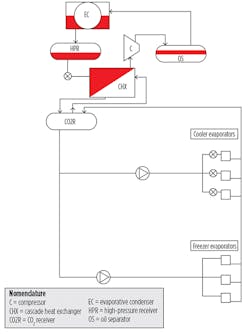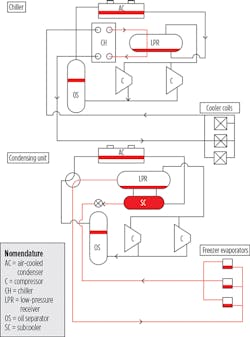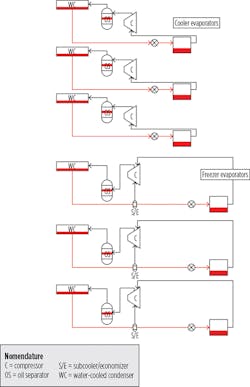Minimizing Ammonia Charge in Industrial Refrigeration Systems, Part 2 of 2
Editor’s note: This article, Part 1 of which was published in the August 2015 issue of HPAC Engineering, is adapted from the white paper “Low Ammonia Charge Refrigeration Systems for Cold Storage,” published by the International Association of Refrigerated Warehouses and the International Association for Cold Storage Construction. To read and download the full paper, go to http://bit.ly/NH3_paper.
Last month, Part 1 of this article provided an overview of two of five new and emerging alternatives to conventional pumped-recirculated-liquid (PRL) systems with the potential to significantly reduce ammonia- (NH3-) refrigerant charges:
- Advanced direct-expansion (also known as dry expansion or DX) systems utilizing electronic expansion valves, categorized as central systems, meaning they are used to minimize or eliminate unused NH3 charge.
- Carbon-dioxide (CO2)/NH3 cascade systems, categorized as hybrid systems, meaning they are used to confine NH3 charge to the machine room and use a secondary coolant in cold rooms.
This month, the article concludes with discussion of another hybrid system—CO2/NH3 with pumped volatile brine (PVB)—and two examples of packaged—meaning they eliminate interconnecting piping and corresponding NH3 inventory with numerous smaller, self-contained systems—systems:
- A line of air- and water-cooled NH3 packaged chillers and a line of air-cooled condensing units.
- A line of self-contained refrigeration systems.
Hybrid Systems (continued)
CO2/NH3 with PVB
A CO2/NH3-with-PVB system has much in common with a CO2/NH3 cascade system. In this system, however, there is no primary CO2 compressor. It is possible there may be a small CO2 compressor for hot-gas defrost, but there are other options that allow for defrost without the addition of a compressor. To many, this can be described as a chiller system. Most chiller systems, however, use water or some formulation of glycol/water, and the cooling coil is not an evaporator, but, rather, just a sensible-heat exchanger. This has an enormous impact on not only the amount of heat-transfer fluid required to meet the cooling load, but on pump size, pumping power, piping size, and heat-exchanger size. Compared with a traditional chiller system, a CO2/NH3-with-PVB system has higher energy efficiency and, usually, a lower installed cost. Actual data for industrial refrigeration systems is scarce; in similar systems for commercial refrigeration, the pumping power required to circulate CO2 as a volatile secondary refrigerant has been found to represent about 5 percent of the power that would be required to circulate a non-volatile secondary refrigerant, such as water or glycol.4
CO2 systems typically operate between 83 psi and 507 psi. What that means is the piping always is under pressure, and the ability for water or air to be drawn into the system is virtually non-existent.
Figure 3 shows a system in which liquid CO2 is cooled to a temperature low enough to satisfy the cooling loads in the freezers. The liquid is cooled to the required temperature in the cascade heat exchanger and then stored in the CO2 recirculator vessel. This same refrigerant then is used to satisfy the cooling loads of the coolers. The key component in meeting the cooler requirements is the pulse-width modulating valve, which is used simply as a metering device to supply enough refrigerant to meet the load requirements of the coolers. The intention is not to evaporate all of the refrigerant, but, rather, simply to satisfy the room temperature setting.
This approach was chosen for the hypothetical facility in this study because of the high ratio of freezer load to cooler load. Because there is no compressor and no suction accumulator, no effort is made to ensure liquid is not carried out of the evaporators. The main driver is the temperature at which coolers typically operate. If the cooler is set at, say, 55˚F, and the evaporator has been designed for a 10˚F temperature difference, the CO2 would be operating at nearly 600 psig. While this is not an unmanageable number, it does push some of the equipment (especially the pump) to its limit.
The special considerations for CO2/NH3 with PVB are nearly the same as those for CO2/NH3 cascade (see Part 1), except oil is not required for the system.
For blast freezing, the temperature of the NH3 available to condense CO2 liquid as low as -50˚F needs to be on the order of -60˚F. For all practical purposes, this requires a two-stage refrigeration system for the NH3. At first glance, it might appear the charge will be quite high because of the two compressors, an intercooler (optional), and a heat exchanger large enough to satisfy the entire load of the cold-storage facility. Keep in mind, however, that there is minimal piping, no evaporators (other than the cascade heat exchanger), a condenser, and only a modestly sized receiver.
Although it is believed actual NH3 refrigerant charge could be as low as 2.5 lb per ton of refrigeration (TR), there is little data to support this. For the purposes of this article, the system’s NH3 charge will be assumed to be the same as that of the CO2/NH3 cascade system, or 6 lb per TR.
One of the main features of CO2 is its high heat-transfer coefficient, which leads to smaller temperature differences in both evaporators and cascade heat exchangers. Additionally, pumping power requirements are low for CO2. The result is system efficiency close to that of a PRL system.
The use of CO2 volatile brine is not new, but has had limited deployment in cold-storage applications. For the purposes of this article, the CO2/NH3-with-PVB system will be assumed to be only slightly more energy-intensive than the baseline system. This assumption is based on a generalized view of the “energy consumers” in the system and how they would be expected to compare to an equivalently sized baseline system. The value that will be used in this article is 2.5 KW per TR.
The installed cost of the system likely will be very close to or slightly higher than that of a CO2/NH3 cascade system. The NH3 refrigeration system will be larger and more costly, but there are no CO2 compressors, unless hot gas is the desired route for defrost. The cascade heat exchanger will be larger for the CO2/NH3-with-PVB system, but there will be no need for an oil still. With this in mind, a conservative estimate for the cost of the system is $7,400 per TR.
Regarding maintenance cost, because all of the NH3 is confined to the machine room, oil sumps are very manageable, and oil draining is limited to a significantly reduced number of vessels. Because the volatile-brine system has no requirements for oil, there is no oil-draining requirement.
On the additional-cost side of the equation, filter dryers must be monitored and maintained on a routine basis. Also, a backup condensing unit is highly recommended for periods of “standstill.” This system also must be maintained routinely to ensure it is in good working order when and if it is needed.
The overall conclusion regarding maintenance costs is that any increase in cost over that of a conventional PRL system will be minimal.
Packaged Systems
Air- and water-cooled NH3 packaged chiller and air-cooled condensing unit
A UK manufacturer offers a line of packaged systems offering a number of basic advantages, including:
- No need for a machine room.
- Avoidance of a large-scale vessel for holding NH3 charge.
- Minimization of distribution piping throughout a facility.
The chiller (Figure 4) exhibits a key feature of hybrid systems in providing refrigeration to coolers and docks itself. The overall impact is a dramatically reduced NH3 charge, with no NH3 present in the rooms being cooled by the chiller. The downside is a negative impact on system efficiency as a result of the extra heat exchanger (the chiller) and the subsequent inefficiencies of pumping glycol to sensible-heat exchangers instead of true evaporators.
The chiller-system designs do, however, incorporate a number of features providing advantages related to installation cost and timing. Standard features aimed at improving energy efficiency include:
- Floating head-pressure control.
- Floating suction-pressure control.
- Variable-frequency drives for condenser fans.
- High-efficiency screw compressors.
The chiller introduces the concept of critically charged systems, systems in which the refrigerant always is undergoing change (expansion, compression, heat transfer)—that is, there is no excess refrigerant residing in the system waiting for the moment when more refrigerant is needed in some part of the process. While this is not a new concept for smaller residential and commercial air-conditioning and refrigeration systems, it represents a significant deviation from the typical PRL industrial refrigeration system.
The chiller utilizes NH3 as the primary refrigerant in “chilling” a secondary heat-transfer fluid for medium-temperature rooms in a cold-storage facility. The secondary heat-transfer fluid usually is glycol. As seen in Figure 4, the glycol is cooled with a plate exchanger in the package and then distributed to docks and coolers as required. The condensers may be air-cooled or water-cooled. The manufacturer has developed seven models of air-cooled units capable of providing 60 to 300 tons of refrigeration. Advanced features incorporated into the design include variable-speed fans for air-cooled condensers, high-effectiveness condenser coils, a fully automatic oil return, and a fully integrated programmable logic controller (PLC).
The condensing unit (Figure 4) utilizes only NH3 refrigerant. As with the chiller, refrigerant charge is minimized as a result of the packaged approach, along with a number of advanced design features, including high-effectiveness evaporator and condenser coils, an ultralow-charge, low-pressure receiver, and a highly efficient defrost methodology. The defrost methodology is worth noting in that the system acts like a heat pump: During defrost, the evaporators act like condensers, giving up heat to melt ice on them, and the condenser acts like an evaporator, revaporizing defrost condensate. (PRL with hot-gas defrost acts similarly to the “heat pump” system described here, the key difference being that, in general, PRL uses an additional and separate external piping system to effect defrost, whereas the condensing system described here simply reverses the flow of refrigerant in the same pipes during defrost.) The manufacturer believes the net result is a defrost cycle that is faster and more energy-efficient than a traditional hot-gas defrost cycle. The key component is a four-port valve within the condensing unit. This is the only valve required for the reverse-cycle defrost, which makes for a greatly simplified system with far fewer valves than a traditional hot-gas defrost system.
The condensing unit uses a unique low-pressure-receiver (LPR) design enabling all control valves to be located within the condensing unit. This eliminates the need for valve stations at the evaporators, greatly reducing the number of potential leak paths, improves efficiency, and simplifies maintenance. An additional feature helping to minimize charge is the low overfeed rate of the evaporators. The combination of the LPR and advanced aluminum evaporators has led to a highly efficient system with minimal refrigerant charge, no pump, and no valves or mechanical joints in refrigerated rooms.
Five air-cooled models ranging in capacity from 25 TR to 71 TR when rated at -10˚F are being offered. The manufacturer anticipates the release of higher-capacity units and units capable of blast freezing in the near future.
Figure 4 shows the installation of two condensing units in a typical cold-storage facility. Units can be ground-mounted or roof-mounted. The idea behind roof mounting is to be close to the evaporators and, thus, reduce the amount of charge in the piping system. Structural and seismic factors, however, must be considered when mounting a fairly heavy package—weights of the units range from just over 100 lb per square foot to 200 lb per square foot—on a roof.
The refrigerant charge of these units depends on the type of condenser, the location of the packaged system in relation to the evaporator, and the size of the package in relation to the actual load requirements.
With air-cooled condensers, energy usage typically is:
- Condensing unit: 2.5 to 2.7 KW per TR at -10°F.
- Chiller: 1.15 to 1.25 KW per TR for a 45°F room.
Not shown in Figure 4 is the manufacturer’s total inline freezing and chilling solution, which utilizes an evaporative, rather than air-cooled, condenser. This package is used for blast freezing and has been demonstrated to be highly energy-efficient; energy usage typically is 2.7 KW per TR for -30°F blast freezing.
In the case of packaged systems, installed cost typically varies inversely with system size. Smaller (under 200 TR) systems usually show an installed-cost savings of 10 percent to 20 percent compared with a central system (PRL). Average-size (200 to 500 TR) systems, because of the large percentage of load going to the blast freezers, cost about the same as a central plant. Large (over 500 TR) systems with typical coolers and higher-temperature freezers require a premium of about 10 percent compared with a central system.
The design of the chiller and condensing unit is such that most components are housed inside of a robust package and easily accessible for maintenance. They have a history of being relatively trouble-free. Features include:
- Automatic oil return.
- A PLC that monitors various key parameters in the system and issues alerts warning of developing problems.
- Two compressors, only one of which runs at a time under most circumstances.
- Air-cooled condensers, which eliminate the need for water treatment.
All other maintenance listed in the manufacturer’s operating and maintenance manual is similar to that of a PRL system.
Self-contained refrigeration system
Six years ago, a self-contained refrigeration system utilizing a number of proprietary technologies related to liquid feed to evaporators and a unique liquid-feed control algorithm was conceived. The first test cell went into operation in 2012; since then, a number of beta sites have been installed. In 2013, the first complete refrigeration-system penthouse unit went into operation in place of a flooded NH3 system that held approximately 500 lb of NH3 charge. The penthouse unit runs with approximately 5 lb of NH3 charge. That charge can be increased by 40 percent as a safety factor, which brings the total charge to still only 7 lb (approximately 0.5 lb per ton). This represents the lowest NH3 charge of all of the systems under review in this article.
The penthouse-style system consists of one compressor, one evaporator, and one liquid-feed valve system and control system. The system can be applied to coolers, docks, freezers, and blast freezers. As with all packaged systems, multiple stand-alone systems of varying capacity and temperature requirements will be installed in a facility, depending on the refrigeration requirements.
There are different options for condensers: air-cooled, water-cooled, central cooling tower, and advanced air-cooled heat exchanger. All of the numbers in this article are reflective of water-cooled condensers with a central cooling tower.
Figure 5 shows a “generic” system. The system operates very much like a DX system, except instead of superheat at the outlet of the evaporator, vapor quality (the ratio of vapor mass flow to total mass flow) is measured at various points in the evaporator, and liquid feed is adjusted accordingly.
With installation typically on the roof of buildings, structural and seismic considerations must be taken into account. Weight loading of each unit is estimated to be 40 to 60 lb per square foot.
The estimated power consumption of the system in Figure 5 is 2.4 KW per TR.
The installed cost of the system can vary significantly from one region of the country to another, based on structural requirements, labor rates, weather conditions, local codes, and more. Nevertheless, the self-contained refrigeration system takes a great deal of guesswork out of installation costs in that the only major on-site installation variable is the roof penetration. With that in mind, installation costs for a generic system are an estimated $7,000 per TR.
Similar to the air- and water-cooled NH3 packaged chiller and air-cooled condensing unit, the self-contained refrigeration system requires less maintenance than any type of central system.
Summary
This article reviewed five alternative industrial refrigeration systems capable of addressing growing concern over high NH3 refrigerant charges in cold-storage facilities. What’s more, adoption of any of these systems does not appear to negatively impact to any significant degree such high-priority variables as energy, installed cost, and maintenance cost.
General conclusions that can be drawn include:
- All of the systems highlighted in this article offer significant reductions in NH3 refrigerant charge. The advanced DX system offers an impressive improvement in NH3-charge inventory, but pays a penalty for its centralized NH3 distribution system. The two CO2/NH3 systems offer even greater improvements in NH3 refrigerant charge, but introduce a challenging (though good) second refrigerant. The air- and water-cooled NH3 packaged chiller, air-cooled condensing unit, and self-contained refrigeration system offer the greatest reductions in NH3 refrigerant charge, but might not offer economies of scale in very large industrial facilities.
- The energy consumption of each of the reviewed systems appears to correlate fairly closely with that of a “soft” optimized PRL refrigeration system. In each case, improvements in basic energy-consumption values can be made. Most of these improvements will require additional capital cost, and some may require an increase in refrigerant charge.
The reader is cautioned not to rely too heavily on the values presented here, as supporting data are minimal, and numerous factors related to facility construction (insulation, doors, vestibules, etc.) can have a significant influence. The point of emphasis here is that, fundamentally, the systems appear to have very similar operating characteristics from an energy perspective.
Reference
4) Pearson, S.F. (2012). Charge minimization. Paper presented at IIAR Conference, Milwaukee, WI.
National business-development manager for Danfoss Industrial Refrigeration, Terry L. Chapp, PE, has been involved in all aspects of HVACR, with particular emphasis on heat exchangers, valves, and controls, over the last 35 years. He is a member of The American Society of Mechanical Engineers, ASHRAE, the International Institute of Ammonia Refrigeration (IIAR), and the Refrigerating Engineers and Technicians Association. He serves on the safety committee of IIAR and the refrigeration and engineering committee of the Global Cold Chain Alliance.
Did you find this article useful? Send comments and suggestions to Executive Editor Scott Arnold at [email protected].




